When words fail or hard to come by, art speaks. Alzheimer’s can’t take away the joy of creation. There’s a secret language with arts & crafts, it’s made of textures, colours, and creativity. It’s a universal language and different crafts can engage, stimulate, bring enjoyment to your loved with Alzheimer’s.
In this blog, we explore 10 craft ideas designed to stimulate memory and spark joy, whether you’re a dementia caregiver, family member, or friend, these creative activities offer a way to bond and create new memories together. Just make sure to choose something that they love, suits their abilities or something you can support them with!
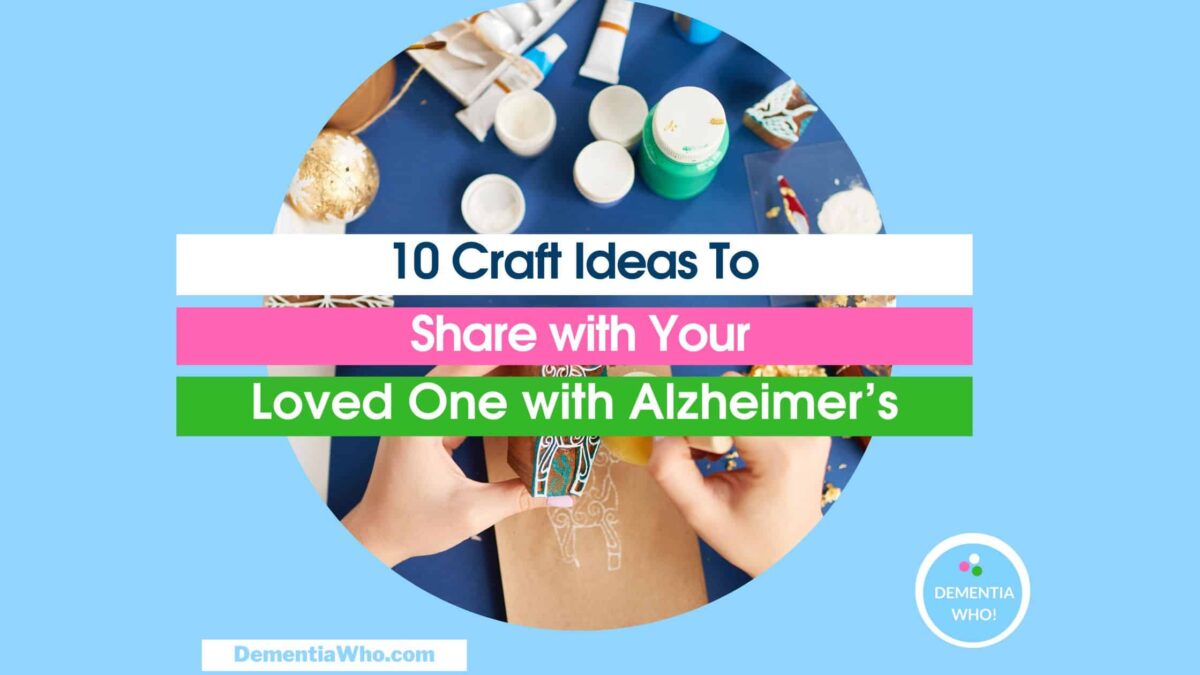
Benefits of Crafting for Individuals with Alzheimer’s
Engaging in creative activities can offer many benefits for loved ones living with dementia. Depending on the craft, they can boost cognitive function and emotional well-being.
Crafting can help stimulate the brain and the sensory nature can help reduce anxiety and stress.
There’s also the sense of accomplishment of finishing something your working on that can boost self esteem. Joining groups or inviting friends over can also reduce social isolation and help improve mood.
Strengthening Connections with Loved Ones
Crafting together helps build stronger emotional connections. One of the things mum used to love was different forms of sewing with her trusty sewing machine to help. It helped lift her spirits, making things for families and friends, so it’s something I continue to do with mum today. It’s something we can do together, but I need to support mum much more now as her Alzheimer’s has progressed, but she’s still very vocal with great ideas to improve my own woeful efforts!
With the right craft ideas, you can make special moments that boost our loved one’s mind and heart. I know that for my mum that it makes her feel happy and stress free when doing arts and crafts. So here are 10 craft ideas to share with your loved one with Alzheimer’s.
Creative Activities to Share with Your Loved One with Alzheimer’s: 10 Craft Ideas
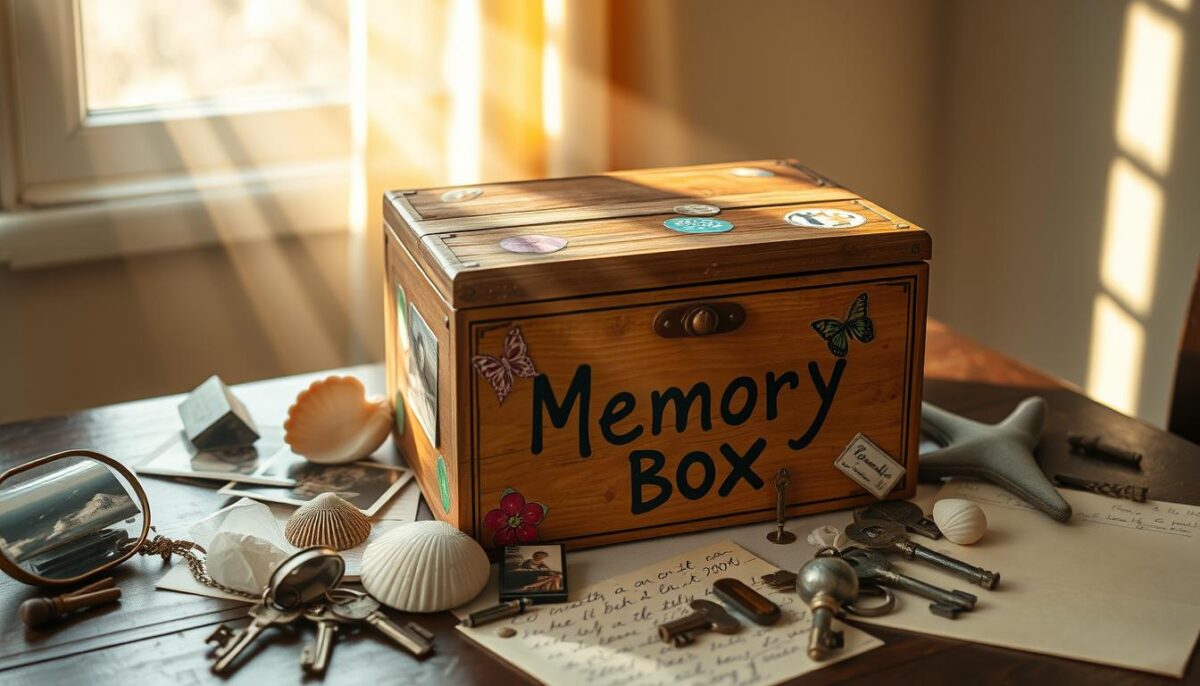
Craft Idea 1: Creating a Memory Box
Making a memory box is a special way to bring back memories and keep the mind active for people with Alzheimer’s. It helps you bond and talk about happy times while making unique keepsakes. A clear plan makes it a fulfilling activity for you and your loved one.
****Important Note: With anything that evokes memories, like photos, mementos, keepsakes, please be aware that not all memories will be good, and could trigger bad memories or upset someone, try to stick to objects that you know hold good memories where possible, or watch body language reactions of your loved one with Alzheimer’s*****
Materials Needed and Step-by-Step Instructions
To make a memory box for Alzheimer’s, you’ll need:
- A box, something resembling a shoe box size or slightly bigger
- Decorative items such as paints, stickers, or fabric
- Photos, postcards, and small mementos that reflect personal history
- Labelling materials for identifying items
Start by decorating the box with your loved one. Then, fill it with things that bring joy and connection. Add different textures, smells, or sounds to make it more engaging, tapping into the person’s memories.
How to Personalize the Memory Box with Meaningful Items
To make a memory box for dementia truly special, fill it with things your loved one loves and remembers. This could be family photos, favourite books, or letters from loved ones. Adding labels with names or phrases helps them remember what each item means, making the experience even more meaningful.
Craft Idea 2: Simple Collage Art
Making simple collage art is a fun way to keep loved ones with Alzheimer’s engaged in creative activities. It uses old magazines, photos, and various textures. Collage Art is simpler art method that doesn’t rely on’technical skill’. It allows dementia caregivers to support their loved ones where needed, and allows those creative juices to flow for your loved one. The textures, smells, sticking down items all add to the sensory experience. Where your loved one has more advanced dementia, helping them by picking out collage items, talking about them, using materials that have different textures, using touch can all help make the experience enjoyable.
Using Old Magazines, Photos, and Textures
Collect materials like old magazines, family photos, and different textures like coloured tissues for a fun collage. Add tools like tissue paper, glue, and safety scissors. It’s important to use non-toxic materials for safety. As you work, ask your loved one about the images they pick, what the materials feel like, whether they enjoy the colours, what’s their favourite part of it etc. This can start deep conversations and bring you closer.
Encouraging Self-Expression and Creativity
Collage art projects boost the well-being and creativity of those with Alzheimer’s. Picking and arranging materials gives them a chance to explore with their senses. It also helps with fine motor skills. By making their own piece, they get to express their feelings & share their art viewpoint.
Collage art can be both therapeutic and enjoyable. It’s a great way to build connections and improve well-being. Adding art to your loved one’s life can create lasting memories and shared moments. Take the time to enjoy making things together, and celebrate every creative moment!
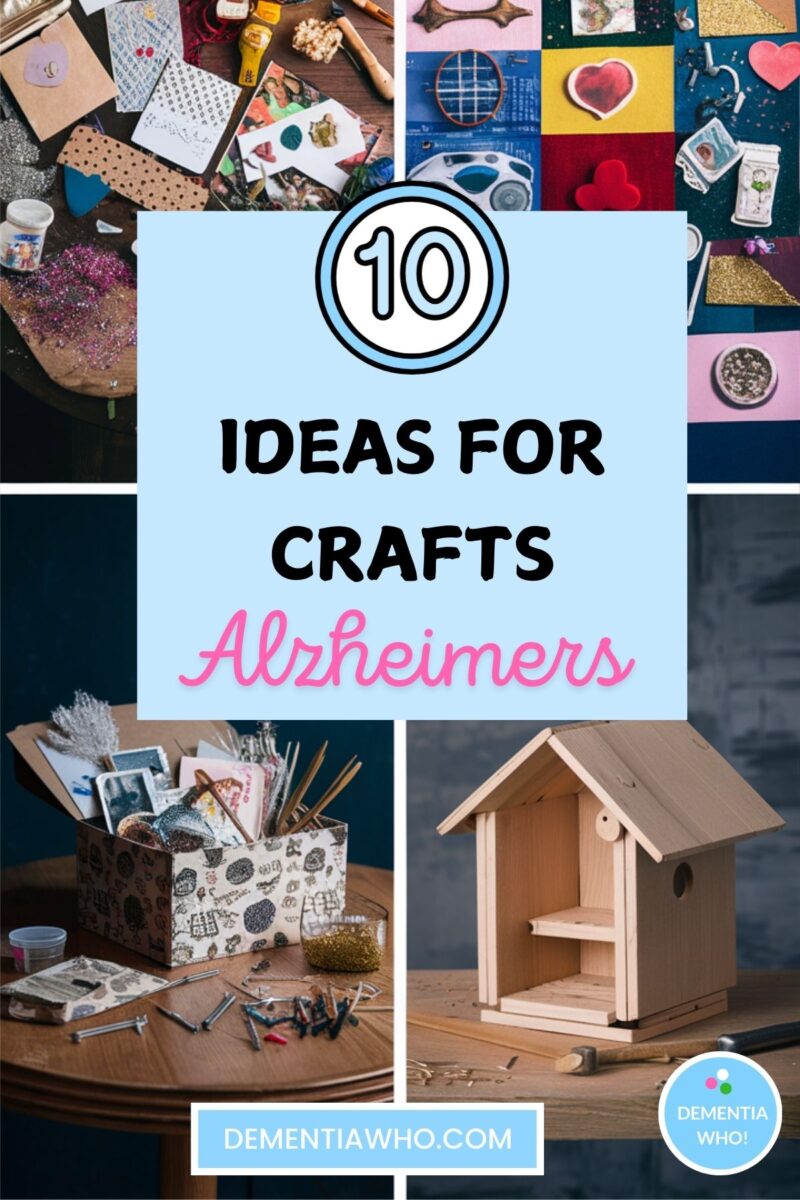
Craft Idea 3: Painting with Watercolours
Painting with watercolours is a great way for people with Alzheimer’s to be creative and relax. It’s important to use safe, non-toxic materials. We joined an art class for people with dementia and their carers, and it became the highlight of our week as mum created pieces by dabbing paints that were amazing, and at the same time we enjoyed the company of the others in the room, sharing stories and laughing together.
Choosing Safe, Non-Toxic Materials
It’s key to pick the right materials. Look for watercolour paints that say they are non-toxic and choose well known brands that are safe and of high quality making it safer for use for loved ones with dementia.
Guided Themes and Ideas for Painting Sessions
Adding themes to painting can make it more interesting. Our art class had a different theme by varying format, but you could focus on creating art about nature, family, or places they love. This can start conversations and help them remember things. Each session can help with feelings and thinking skills. It also helps with fine motor skills holding and using different size brushes.
Watercolour painting is a great way to support your loved one and can help them connect with others and feel better emotionally.
Craft Idea 4: Making a Family Photo Album
Making a family photo album is a great way to help someone with Alzheimer’s remember their past. It’s a fun project that also helps with storytelling. By working on it together, you can learn new things about your family, share funny memories or sentimental moments that build your connection with your loved one. It’s a chance to bond and share stories.
Organising photos and telling stories is key to this craft. It’s a way to bring back happy memories and it’s a project that’s both fun and meaningful.

Organising Photos and Creating Narratives Together
You’ll need to be patient as it might take time when putting together a family photo album. Your loved one with Alzheimer’s, may need more time to remember and to think about what each photo means. but don’t stress about it and help or move on to other items if they’re struggling.
Tips for Customising and Decorating the Album
Adding a personal touch to the album makes it even more special. Here are some ideas:
- Use stickers and decorations that show what you both like or share.
- Add personal notes and captions to tell the story of each photo.
- Try using different textures in the album for a sensory experience.
I loved going through old albums with my mum, picking out photos and talking about them.
Craft Idea 5: Decorating Flower Pots
Decorating flower pots is a fun way for you and your loved one to spend time together. You can use paints, stickers, and other decorations. This activity is great for people with Alzheimer’s because it helps them be creative and improve their fine motor skills. It also gives them something beautiful to look at.
After decorating, you can plant flowers or herbs together. This makes the project even more special. It turns the decorated pots into a living piece of art.
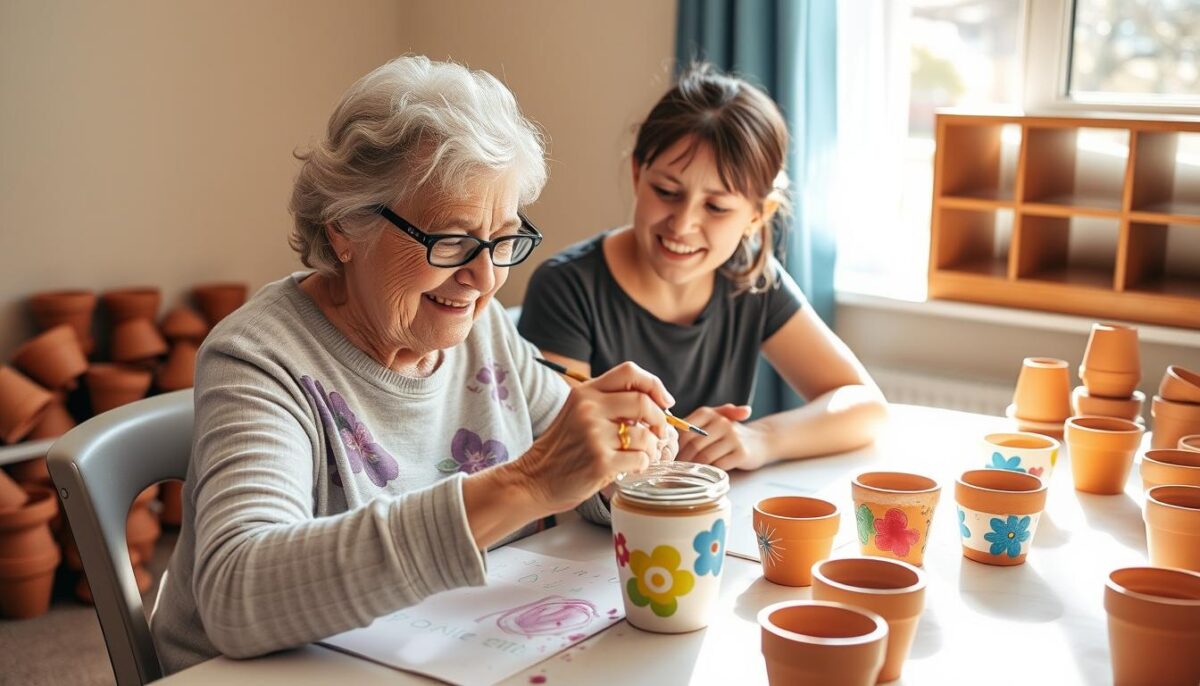
Using Paint, Stickers, and Other Decorative Items
You can easily find the materials you need for decorating flower pots. Here are some things you can use:
- Terracotta pots
- Tissue paper and decoupage glue
- Acrylic paints
- Colourful stickers
- Natural elements, such as leaves or twigs
- Glitter or beads for extra embellishment
Let your loved one show off their artistic side. Decorating flower pots can be very fulfilling. You can feel proud and enjoy the beauty of what you’ve made. Plus, it’s a chance to talk about favourite colours or flowers & plants.
Planting Flowers or Herbs as a Follow-Up Activity
After decorating, it’s time to plant the flowers or herbs. Choose easy-to-grow plants like:
- Marigolds
Petunias
Basil
Rosemary
These plants are easy to care for and add colour to the garden. Your loved one can use these to smell, touch and use in cooking as well as admire from afar their art work.
Craft Idea 6: Stringing Beads for Simple Jewellery
Creating simple jewellery with beads is a fun way to spend time with a loved ones with Alzheimer’s, and is a great activity to involve the kids with too! You can purchase ready made packs of with all the materials needed to make string beads, or you can purchase diy materials from craft stores. Using bright, colourful beads makes the project more engaging and rewarding when the jewellery is worn or given away as gifts.
Choose light-weight beads that are easy to hold. Also, pick soft string or elastic for the jewellery to make it easier to make. Think about dexterity and how you can help. Be careful and vigilant that the beads are not mistaken for sweets. This may be one activity that might be more be suited to someone with early stage dementia.
Encouraging Focus and Fine Motor Skills
Stringing beads is a relaxing and calming activity and can be a mindful activity for someone living with dementia. It also helps with fine motor skills. The action of threading beads can help retain agility with your fingers. Crafts like this boost confidence and can slow down cognitive decline, and hopefully you’ll feel better emotionally.
Craft Idea 7: Creating Handmade Greeting Cards
Making handmade greeting cards is a lovely way to spend an afternoon with a group of friends, crafting together, allowing you to demonstrate your creativity and send lovely cards to family and friends. You can use materials like stamps and stickers to make the cards special, add glitter, spritz with perfume. Think about suggesting themes e.g making them for upcoming holidays, special celebrations etc and conversation can revolve around who to give the cards to, making it a fun and social activity.
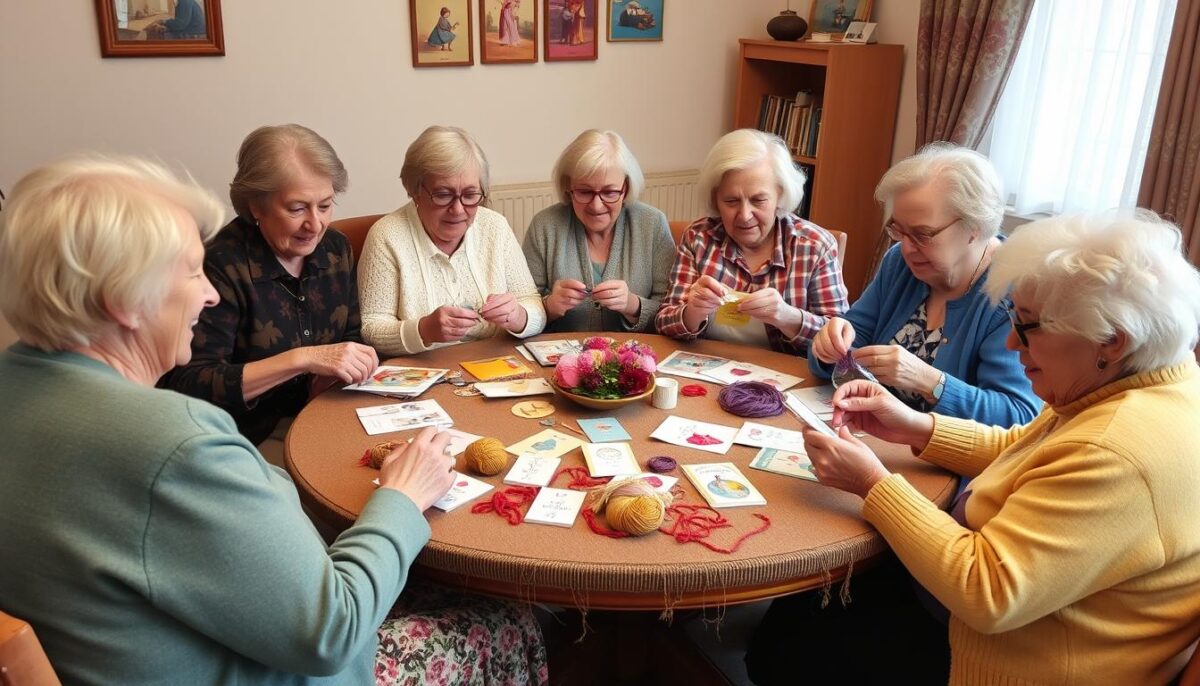
Using Stamps, Stickers, and Personal Messages
This craft is a great way to keep loved ones with Alzheimer’s busy and creative. You can try out lots of different designs and styles. All you need are a few simple things, making it easy to start and fun to do.
Sharing the Cards with Friends and Family
After making the cards, think about sharing them with people they care about. Writing messages or using hand prints in the cards can help loved ones stay close to family and friends.
Craft Idea 8: Building a Birdhouse or Bird Feeder
Building a birdhouse or a bird feeder is a great way for loved ones with Alzheimer’s to enjoy the outdoors. It lets you bond with nature and do something rewarding. You can purchase easy-to-assemble kits for birdhouses make it safe and fun for everyone, no matter their skill level. Bird feeders can be made from various materials
There are many designs of birdhouse or feeder kits available. They come with pre-cut wood and safe paints. After making your birdhouse or feeder, you can watch the birds come to visit.
Craft Idea 9: Decorating Picture Frames
Decorating picture frames is a great way to make something special with your loved one. It lets you add a personal touch and sparks creativity. Collect items like buttons, shells, or fabric scraps for decoration. These are easy to find and can look amazing on frames. Using things like buttons, shells, and fabric scraps can make a lovely keepsake that can be gifted or used to in your own home to display pictures or art.
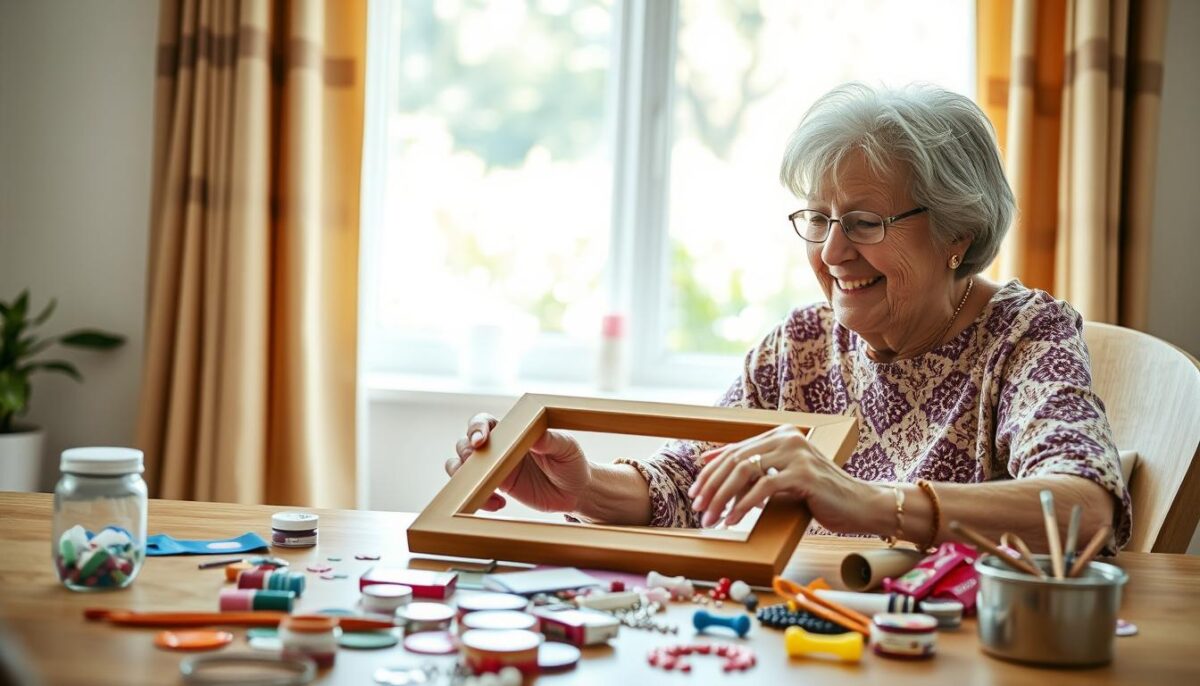
Craft Idea 10: Making Scented Sachets
Making scented sachets with your loved one with Alzheimer’s is great fun and an engaging craft. I love making these as you can hang them in closets and cupboards. It lets your loved one enjoy a multi-sensory experience. You can use fragrant herbs and soft fabrics, which helps with relaxation. These sachets make great gifts or can bring back happy memories with familiar smells.
Selecting Fragrant Herbs and Soft Fabrics & Adding Personal Touches
First, pick herbs like lavender, rosemary, or chamomile. These herbs are calming. Then, use soft fabrics like cotton or muslin for the sachets. Adding bright colours can also make them more appealing to your loved one.
For a personal touch, add embroidery or colourful ribbons. This makes the craft even more special. You could embroider initials or symbols that mean something to your loved one. These touches make the sachets more appealing as gifts to others or for your loved ones and can make crafting more enjoyable.
Tips for a Successful Crafting Experience
When dementia caregivers are thinking about creating a successful crafting experience, it’s vital to adapt crafts to fit the skills and interests of your loved one. Some might like simple tasks, while others might enjoy more complex projects that spark their creativity. Tailoring activities to their preferences boosts their enjoyment and supports cognitive function through art and crafts.
Adapting Crafts to the Skill Level and Interests of Your Loved One
Watching how your loved one reacts and adjusting the craft can make a big difference. Using themes they love can help them feel connected and give them a sense of purpose. The main aim is to keep crafting fun.
Creating a Calm and Enjoyable Crafting Environment
A calm setting is key for a good crafting experience. Reduce distractions and play soft music in the background, as it can reduce disorientation, confusion and can help with stress especially in new surroundings. Making sure your loved one feels safe and comfortable will mean that they can make the most of their time and engage more with the crafts.
Celebrating the Completed Projects Together
Take the time to celebrate the completion of craft projects. Display them at home or gift to family and friends, looking at the work you’ve completed with or without your help can only boosts feelings of pride and achievement. It can encourages your loved one to continue with the activity, especially where they’ve had fun, socialised with others or just had quality time with you that wasn’t about ‘caregiving’ but about enjoying yourselves in the world of crafts sharing and making happy memories.
Conclusion
I hope these 10 craft ideas to share with your loved one with Alzheimer’s have given you food for thought about things you can do together. I hope that whatever you decide that you enjoy it, have fun. It’s not about getting it right, doing things perfectly, it’s the exact opposite, forget the end product—it’s about the journey. It’s all about imperfections, it’s what comes out of trying something new together with your loved one’s living with Alzheimer’s.
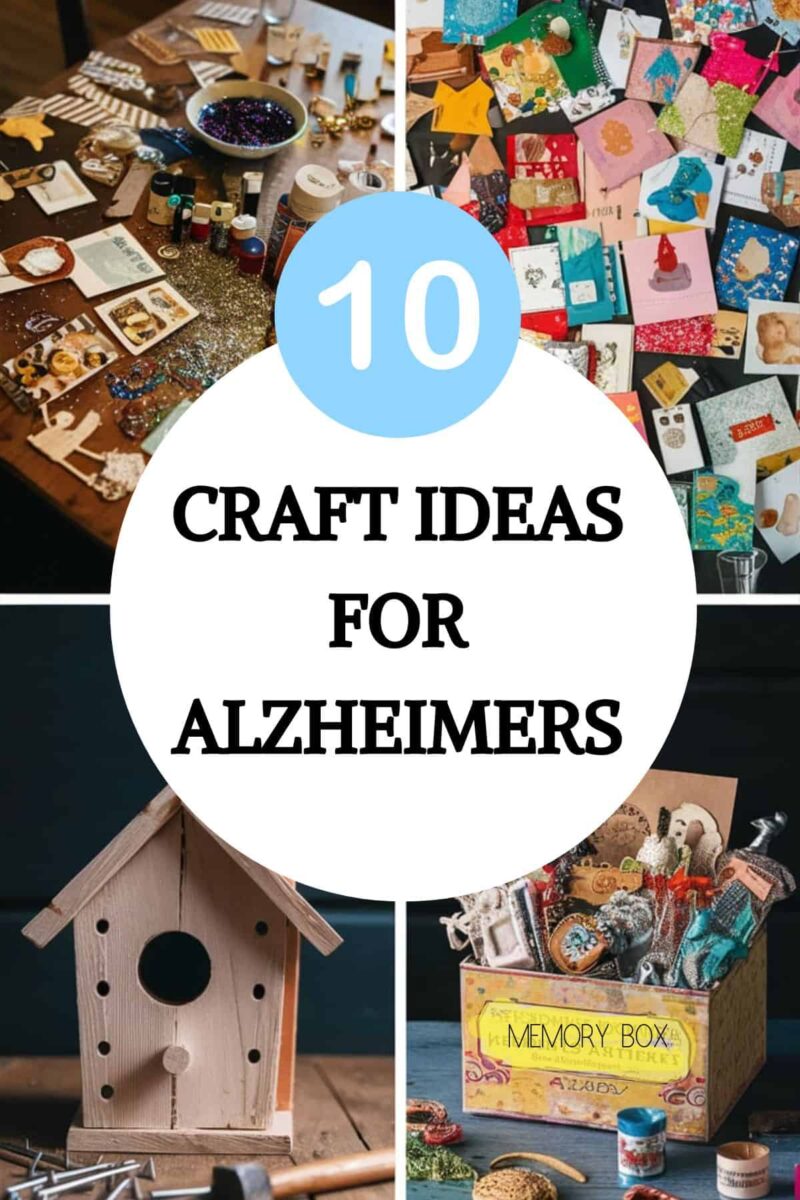
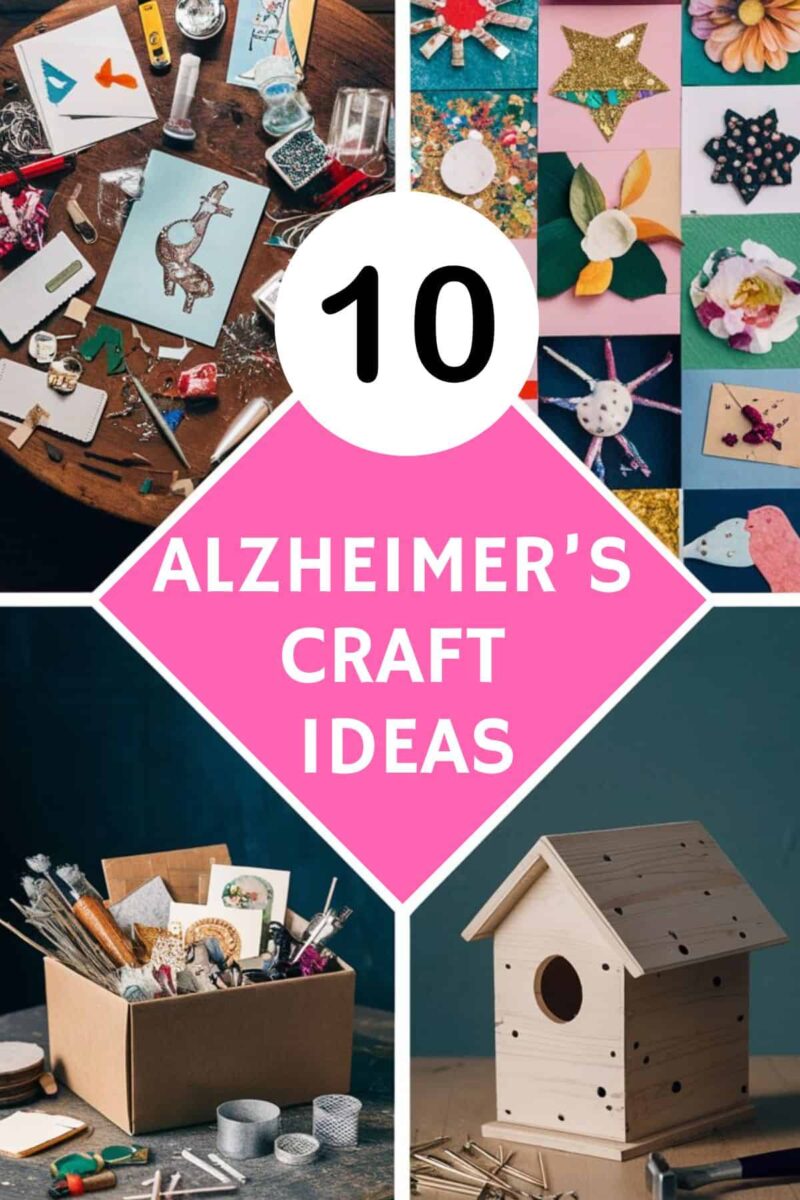
For more activity ideas for dementia, related links below:


